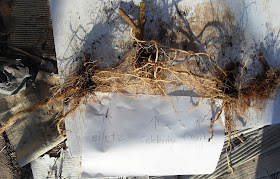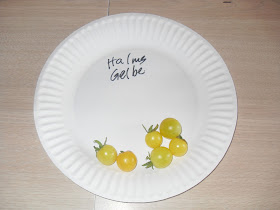 |
| Siletz tomatoes that lack pollination also lack seeds |
This year all the tomato plants in my temporary greenhouse are from the variety Siletz. I usually diversify in the varieties I plant but I was so impressed with the performance of this cultivar last season that I only planted seeds of this variety. I'm still planning on starting a couple other varieties soon. Siletz was the only variety that could even compare to Celebrity in production. And since the taste of the tomato fruit is the least of concerns for Tucson’s tomato gardeners I am willing to have food production be pretty high on my priority list. Don’t get me wrong – a tomato’s taste is important but without shadecloth most tomatoes are lucky to produce a few fruit in Arizona’s summer heat. Many varieties that are advertized as producing an abundant crop of large tomatoes just barely present 1 or 2 cherry-sized tomatoes per plant. When planting anything in my garden I first prioritize what I want. The three things that matter most to me are that the plant is open-pollinated, that it can grow in my climate, and that it produces lots of food. Growing in my climate requires that the plant exhibit vigor, disease resistance, heat resistance, and large fluctuations in temperature.
Although some may scoff at the taste of a Celebrity Hybrid tomato, none will laugh when you compare a tomato plant with 25-50 large fruit on the vine with what many heirloom plants produce in my climate - almost nothing. For this reason some gardeners who try Celebrity may choose not to go back to heirloom tomatoes. This is also the reason that some gardeners who do not grow hybrids make an exception for Celebrity. So why have I been growing a hybrid tomato in my heirloom garden? Because I use Celebrity as a standard to compare my other tomatoes to rather than as a long term solution to my food production needs. It is unfortunate that, within my garden, Slietz has been the only other cultivar that has even compared to Celebrity in fruit production. Both varieties possess a semi-determinate growth habit. Siletz's parthenocarpic nature also allows it to pump out fruit in the middle of the summer when most other varieties begin waning. This last year I planted most of my tomato varieties in a trench (lowered bed gardening) in the middle of my yard and provided west side shade from a bean trellis. The lowered bed method is also used by the Community Gardens of Tucson and is very useful for southwestern gardening. My seed source for this Siletz was Territorial Seed Company.
 |
| Last crop of the season ready for paper bags. No other varieties compared. |





























